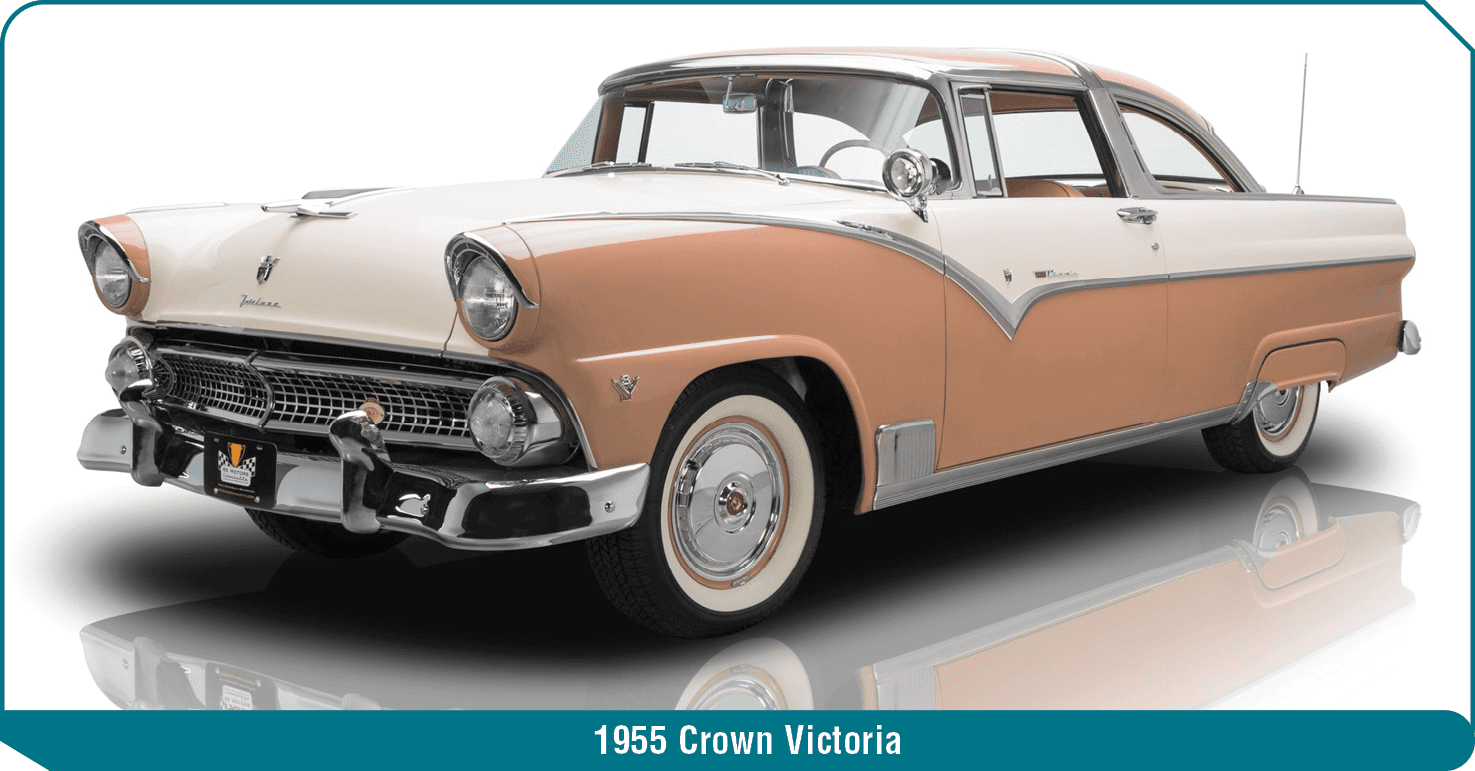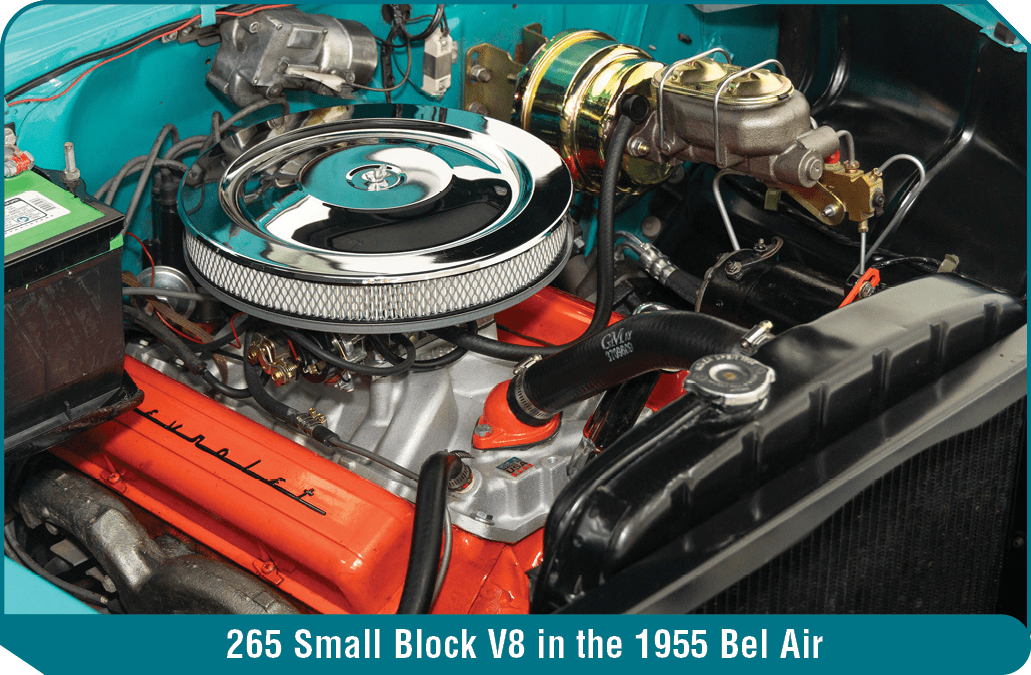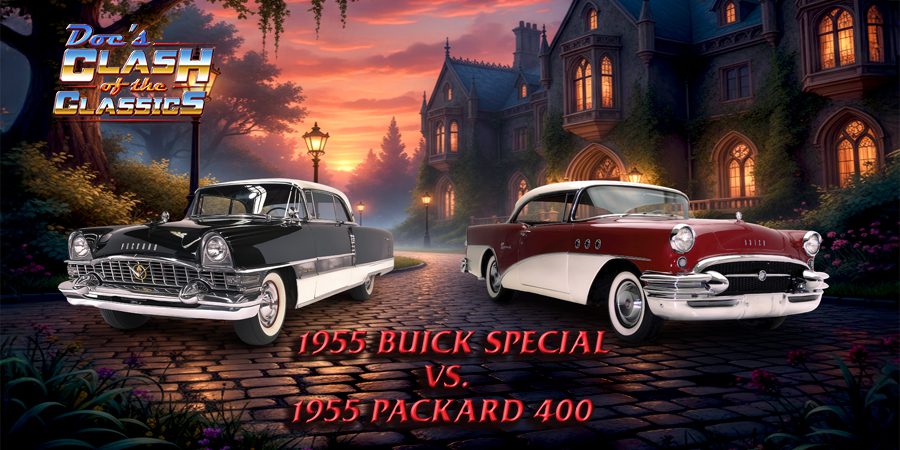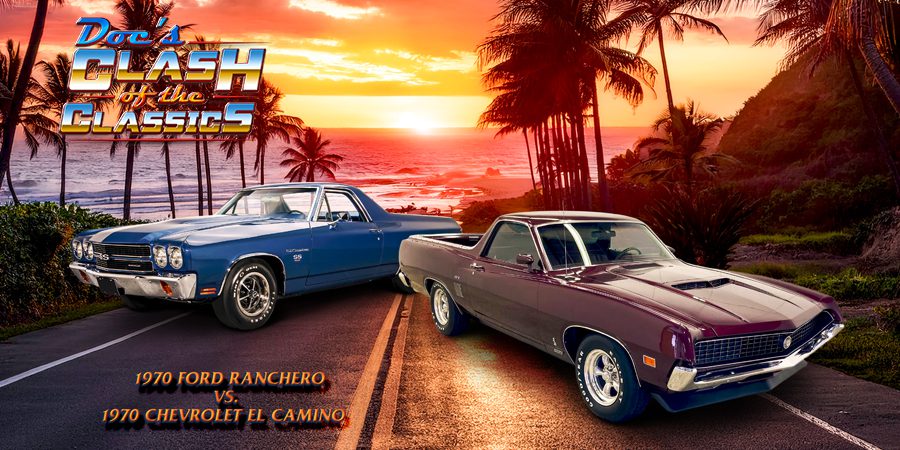Welcome once again, to another edition of Clash of the Classics, our travels take us back to 1955 for this month’s showdown between two classic titans of the mid-20th Century.
The 1950s were arguably the best of times here in America, the country was not only developing newfound technological advancements in seemingly every sphere of investigation, but we were also enjoying economic and financial prosperity never before experienced.
In the automotive world, the term “Hot Rod” took on new meaning with the development of the small block V8. Cruising was becoming popular with young people, carhops, drive-thru’s, and drive-ins were the craze and cool cars were a must-have. Two of the coolest and most iconic cars of the period are the 1955 Chevrolet Bel Air and the 1955 Ford Crown Victoria.
Let’s begin with a brief look at the Bel Air.
To fully appreciate the birth of the Tri-Five Chevy, we have to begin somewhere near the Spring of 1949. It was then that Ford’s redesigned coupe caught the attention of nearly everyone in the country. Nicknamed the “shoebox”, it sold in record numbers. It was far sleeker than its 1948 predecessor and when fitted with Ford’s Flathead V8, it outperformed the Chevy in every way measurable, including acceleration and handling. The Top Brass at GM took notice of Ford’s success which ultimately set in motion what would become the greatest American Classic ever designed.
 Fast-forward to May of 1952, General Motors Chief Engineer Ed Cole and his team were busy designing a platform that was sleeker and more stylish than what was previously available. His budget at that time was an astonishing $300 million and he was determined to spend all of it. Thirty-six months later, the all-new 1955 Bel Air was born, and with it came a level of success that GM could never have predicted.
Fast-forward to May of 1952, General Motors Chief Engineer Ed Cole and his team were busy designing a platform that was sleeker and more stylish than what was previously available. His budget at that time was an astonishing $300 million and he was determined to spend all of it. Thirty-six months later, the all-new 1955 Bel Air was born, and with it came a level of success that GM could never have predicted.
 GM’s Marketing Division quickly went to work, dubbing the car “The Hot One” early in the advertising campaign. The all-new 1955 Bel Air came with several upgraded features such as stainless steel window moldings, interior carpet, redesigned instrument cluster, and the Ferrari-inspired front grille.
GM’s Marketing Division quickly went to work, dubbing the car “The Hot One” early in the advertising campaign. The all-new 1955 Bel Air came with several upgraded features such as stainless steel window moldings, interior carpet, redesigned instrument cluster, and the Ferrari-inspired front grille.
Beginning under the hood, finally, a V8 was now available, and it was an impressive one at that. This is the V8 engine that gave birth to every GM small block since, including the engine that powers the all-new C8 Corvette. It was the 265 V8 small block and it made its debut in the 1955 Bel Air. It was rated at 180 hp and was far more spirited than GM’s best in-line six-cylinder engines used in previous models. Chevy wanted younger buyers, and the youth wanted horsepower. Dave Holls, who was one of Chevy’s lead designers at the time commented: “If there was ever a time when the kids went 360 degrees from Fords to Chevys, it was 1955.”
However, there was still a market available for businessmen and ladies. The riddle of how to capture such a broad audience was solved in part by offering the car with an automatic transmission.
Automatic transmission development was in its infancy during the early to mid-1950s. Up to that time, the clumsiness of the manual transmission was something of a detriment to the female population and Chevy was all too happy to solve that problem. The two-speed Powerglide was the answer, further cementing Chevy’s brilliance with the car. Now, not only did the Tri-five flagship vehicle appeal to the youth but there was also an equipped version that older, more mature Americans could enjoy.
 Outside, the 1955 Bel Air was sleek and aggressive, the Ferrari-style egg crate grille was unique, the lines at the top and bottom were smooth yet distinctive, and the subtly hooded headlights as well as the wrap-around windshield were certainly dramatic.
Outside, the 1955 Bel Air was sleek and aggressive, the Ferrari-style egg crate grille was unique, the lines at the top and bottom were smooth yet distinctive, and the subtly hooded headlights as well as the wrap-around windshield were certainly dramatic.
To improve the ride quality and reduce steering unpredictability that was predominant in earlier platforms, Chevy redesigned the entire chassis and suspension. The Bel Air now had an improved “Glide-Ride” suspension 1955 Bel Air 1955 Crown Victoria with redesigned front control arms, diagonally mounted shocks, an overall lower center of gravity, a wider frame, and tubeless tires.
 The interior was equally impressive with Full bench style front and rear seats with cloth windlace type fabric Chrome headliner bows offered a nice touch and the twin cowl instrument panel with the iconic V-gauge layout has always been one of my favorite designs.
The interior was equally impressive with Full bench style front and rear seats with cloth windlace type fabric Chrome headliner bows offered a nice touch and the twin cowl instrument panel with the iconic V-gauge layout has always been one of my favorite designs.
By mid-1955, Chevy was selling all the Bel Air’s they could build. Estimated production for 1955 was somewhere near 1,775,952 units. On Thursday, April 28, Chevrolet Motor Division set a one-day industry production record, building 7902 cars. The 1955 Chevy Bel Air forever changed the landscape of cars and to this day is an iconic piece of American history.
 The basic 1955 body design would continue for two more seasons, through 1957, but the ’55 remains purest and most historically important.
The basic 1955 body design would continue for two more seasons, through 1957, but the ’55 remains purest and most historically important.
In one car, Chevy miraculously captured the spirit of a nation, harnessed the optimism of the youth, and created excitement that continues even to this day. Ask any classic car enthusiast which car truly represents the entire Chevrolet brand and chances are the response will be the 1955 Bel Air.
Now, let’s look briefly at the 1955 Ford Crown Victoria.
Any time I look back at the earlier years of the automotive industry, I’m reminded of a day when designers weren’t afraid to make significant changes to models year by year. The ’50s were such a time. The 1954 Crestline series vehicles would ultimately give way to the debut of the 1955 Fairlane and with it came renewed interest and excitement.
 The ’55 Fairlane is one of the most beautiful designs of the period The smooth-flowing line that later became known as the “Fairlane stripe” began at the top of the front fender, and traversed the entire side panel until disappearing at the taillights. The chrome eyelash headlights were an elegant touch as were the chrome window moldings. When it debuted, it became Ford’s top-of-the-line model.
The ’55 Fairlane is one of the most beautiful designs of the period The smooth-flowing line that later became known as the “Fairlane stripe” began at the top of the front fender, and traversed the entire side panel until disappearing at the taillights. The chrome eyelash headlights were an elegant touch as were the chrome window moldings. When it debuted, it became Ford’s top-of-the-line model.
Unfortunately, it didn’t sell as well as Ford had hoped. In 1955 Ford produced an estimated 626,250 Fairlanes and of those, only 33,165 were top-tier Crown Victorias. They were instantly recognizable by the bright metal roof molding that ran across the top of the car between the B posts. Some called it a “Basket Handle” while others called it a “Stainless Steel Tiara”. Either way, it served to separate the front and rear passenger sections and was surprisingly well-received by the press and media.
 There was one, short-lived option for the lineup that Ford called the Crown Victoria Skyliner. Essentially, it was the same car only with a smoked acrylic glass roof. It was impressive to look at both from inside the vehicle as well as outside but tended to bake the passengers on hot sunny days. Ford tried to reduce the penetration of ultraviolet rays but ultimately abandoned the glass roof after two years.
There was one, short-lived option for the lineup that Ford called the Crown Victoria Skyliner. Essentially, it was the same car only with a smoked acrylic glass roof. It was impressive to look at both from inside the vehicle as well as outside but tended to bake the passengers on hot sunny days. Ford tried to reduce the penetration of ultraviolet rays but ultimately abandoned the glass roof after two years.
When it came to power under the hood, the all-new Crown Victoria featured the 272 cid Y-block V8. It was just enough to be a few cubic inches larger than Chevy’s all-new 265 V8 we discussed earlier. Ford bragged that it was a better design than the Chevy and touted their exclusive “Carburetion-Ignition-Combustion System” that was engineered to ensure the fuel mixture is ignited at just the right instant and burned completely to give you the most ‘go’ from every drop of gas.”
 It seems hyperbole was in no short supply in 1955 and while the cubic inch displacement may have been equal to the Chevy, the horsepower output of the Y-block, rated at 162 hp was slightly less than the GM 265 V8 rated at 180 hp.
It seems hyperbole was in no short supply in 1955 and while the cubic inch displacement may have been equal to the Chevy, the horsepower output of the Y-block, rated at 162 hp was slightly less than the GM 265 V8 rated at 180 hp.
When it came to transmissions, Ford truly did have the advantage. While Chevy was offering their perspective buyers an optional 2-speed automatic, Ford was ahead of the game with their 3-speed Ford-o-matic. Some of the brochure literature at that time accurately read, “a new automatic low gear for extra-fast starts, quicker acceleration, and safer passing at low speeds”. As a side note, many of our older readers may agree that Ford used the basic design of that transmission well into the 21st Century. Looking at the latest 4R75E transmission iteration, one will notice striking similarities to that early 50s Ford-o-matic.
Unofficially, Motor Trend magazine reported a 0-60 time of 14.5 seconds for the Crown Victoria which may have been adequate but in the final analysis, Ford was still no match for the Chevy Bel Air, which with 265 V8 and Powerglide could zip from 0-60 in about 12 seconds.
1950s suspension designs were typically unreliable regardless of the manufacturer, but even so, Ford’s ball-joint style front suspension which was introduced on the 1952 Lincoln and 1954 Ford and Mercury were some of the more desirable. Beginning in 1955, engineers made subtle improvements to the front wheel spindles that made a huge difference in overall handling and feel. Ford boasted the redesign as their new “Angle Poised Ride”, which worked well not only for advertising but on the road test as well.
The interior of the Crown Victoria was simple, yet comfortable. The bench seat was reinforced for lumbar support and the vinyl fabric was available in 16 different colors as well as two-tone. The dash and instrumentation were utilitarian and unremarkable with a basic gauge layout. Air-conditioning was available as an option but seldom selected.
During our time hosting the annual Southern California “Fabulous Fords Forever” show, Jeff “Doc” Morgulis and I had the opportunity to experience several 1955 Crown Victorias. It has been, and continues to be one of my favorite models. It is both distinctive as well as timeless with a uniqueness that will continue to be appreciated for generations.
That being said, here at Clash of the Classics, there can be only one winner. While both cars are iconic, the winner and champion of this battle is the 1955 Chevy Bel Air. There were several reasons for our choice but the key factor was the dramatic impact the design had on the nation. For one model to completely reshape an industry is truly remarkable.
As always, we’d love to hear from you, let us know which car you prefer and why.
Until next time when we take a ride on a classic highway, stay safe… stay timeless… stay classic!
About The Author
Donny Caccamise is an Automotive Technology Graduate and a Certified Master Technician with more than 40 years of automotive industry experience. Before retiring, he hosted the Nationally Syndicated Automotive Talk Radio Show “Horsepower for an Hour” airing on 161 AM and FM radio stations across the nation. He is a retired member of the ATRA Board of Directors, and retired transmission shop owner. Vintage and classic cars are his specialty. Contact Donny at donnycaccamise@gmail.com


















The 55 Chevy is definitely the winner as well as the 56 athen the timeless favorite the 57!
Couldn’t agree more with your comment regarding each manufacturer’s new model year’s body, interior and engine changes were extremely exciting. Cars and trucks were delivered to each dealership under the cover of night and were literally covered and under wraps on the delivery trucks. Each year’s unveiling at the dealership’s was a family event for my Dad, brothers and I. Free coffee, donuts or pop for us boys. It was an annual event for me starting in 1953. That was the introduction of the Belair! We visited The Buick, Chevrolet, Oldsmobile, Pontiac and Cadillac dealerships. I dreamed of owning my favorite car every year! It definitely planted the seeds for being obsessed with the excitement of owning my own car, customizing it beefing up the engine and the thrill of drag racing it or just looking cool while cruising the main drag with either a buddy or my date. I have restored several cars over the years and currently own a restored and slightly modified 57Chevy Belair 2dr ht.
While traveling as a young boy I competed with my brother calling out the year make and model of each car that we either met or passed on the highway or as we drove through small towns, try doing that today!
I wouldn’t trade growing up during the fifties and early sixties for anything in the world!
Jon Simon